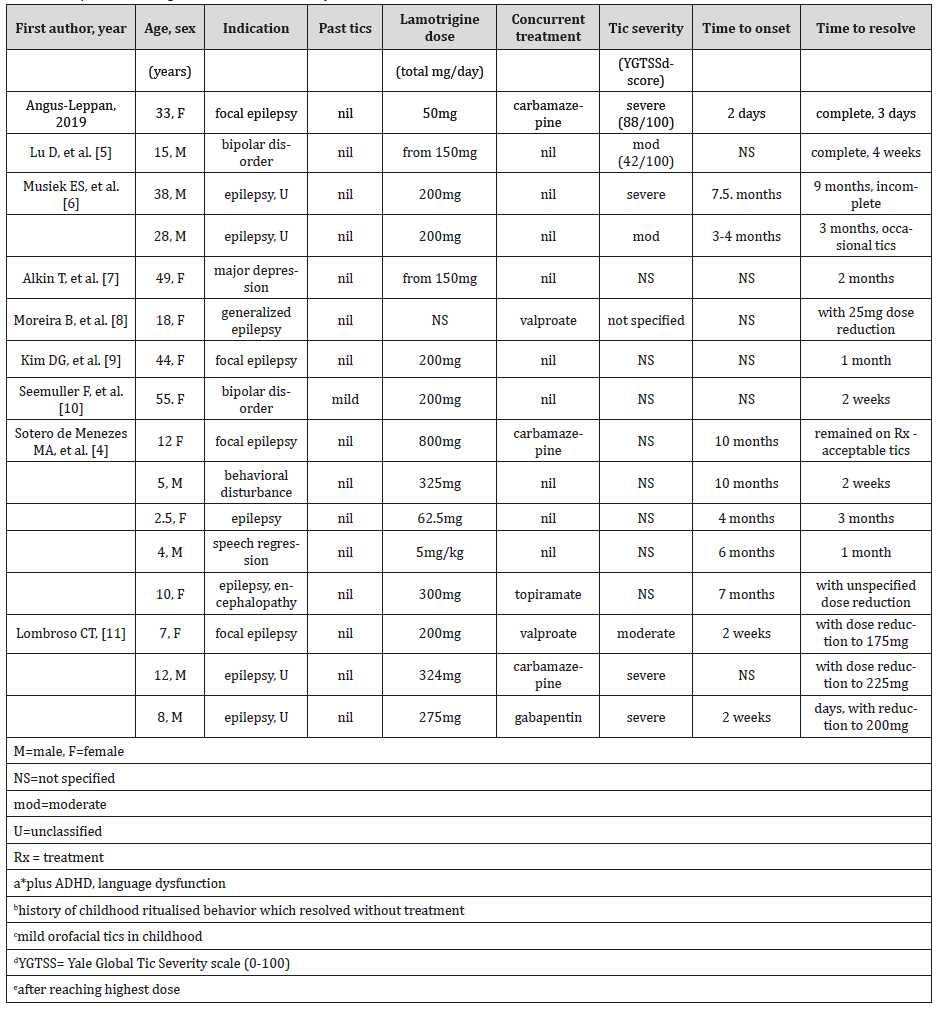 Case Report
Case Report
Recognising Acute Lamotrigine Induced Tourette’s Syndrome in Adults
Angus-Leppan H1,2,3*, Nash A1 and Pilling R1
1Department of Clinical Neurosciences, Royal Free London NHS Foundation Trust, UK
2Institute of Neurology, UK
3Centre for Research in Public Health and Community Care, University of Hertfordshire, UK
Angus-Leppan H, Epilepsy Initiative Group, Department of Clinical Neurosciences, Royal Free London NHS Foundation Trust, UK.
Received Date: February 21, 2019; Published Date: March 15, 2019
Abstract
We report a woman with epilepsy developing acute reversible lamotrigine induced Tourette’s syndrome. This rare reaction is important as lamotrigine is used widely in neurology, psychiatry and pain management.
Case Report
After six years of remission on carbamazepine, a 33-yearold woman with focal epilepsy of unknown cause had a seizure three weeks post-partum. Within 48 hours of starting lamotrigine (25mg twice daily), she developed severe complex motor tics and coprolalia. There was no personal or family history of tics or obsessionality. Tourette’s resolved within 72 hours of stopping lamotrigine. She declined re-challenge. There is no recurrence over nine years. Previous reports of Tourette’s in patients treated with lamotrigine for epilepsy, bipolar disorders or refractory depression demonstrated a dose-dependent effect (Table). Our patient’s symptoms occurred and resolved within 48 hours (compared to a mean 5 months and 72 hours respectively in all reports, see Table), more rapidly than previously reported. The severity of lamotrigine-induced Tourette’s varies from mild to severe. In most patients, lamotrigine was withdrawn, but in 5/16 dose reduction resolved symptoms (Table). Several cases recurred on re-challenge, and 7/16 occurred in adults (see Table) in contrast to primary Tourette’s syndrome (commencing at mean 7 years), occurring in 0.5% of the population [1].
Carbamazepine, phenobarbital and phenytoin [2] as well as lamotrigine, are rare secondary causes of Tourette’s. Only one previously reported patient had a prior tic disorder and 2/16 had pre-existing obsessional traits (Table). No predisposing or genetic factors have been identified, in contrast to primary Tourette’s syndrome [1].
Tourettes syndrome is postulated to be due to basal ganglia and frontal dysfunction [3], along with genetic factors [1]. The mechanism of the reaction to lamotrigine is uncertain. Inhibition of voltage-gated sodium channels and subsequent attenuation of pre-synaptic glutamate release modulates basal ganglia circuitry and is postulated as the cause [3]. Lamotrigine-mediated nicotinic receptor agonism, mediating basal ganglia dopamine release, has also been suggested [3]. Neither hypothesis explains susceptibility in such a small percentage of patients.
Table 1:Reported lamotrigine-induced Tourette’s syndrome.

In our secondary care cohort, lamotrigine induced Tourettes occurred in 0.3% of adults with epilepsy, and a previous report estimated 1.3% in children [4]. The reaction can be delayed up to 10 months after commencing Lamotrigine. A careful drug history is important in Tourette’s syndrome, especially if atypical features, such as adulthood onset, or absent family history. Clinicians should be aware of this reversible cause of Tourette’s syndrome.
Acknowledgement
Our thanks to the patient who gave informed consent for this publication.
Conflict of Interest
None.
References
- Bagheri MM, Kerbeshian J, Burd L (1999) Recognition and management of Tourette’s syndrome and tic disorders. American family physician 59(8): 2263-2272.
- Zaccara G, Cincotta M, Borgheresi A, Balestrieri F (2004) Adverse motor effects induced by antiepileptic drugs. Epileptic Disord 6(3): 153-168.
- McNaught KS, Mink JW (2011) Advances in understanding and treatment of Tourette syndrome. Nat Rev Neurol 7(12): 667-676.
- Sotero de Menezes MA, Rho JM, Murphy P, Cheyette S (2000) Lamotrigineinduced tic disorder: report of five pediatric cases. Epilepsia 41(7): 862- 867.
- Lu D, Lin X, Liu X, Su L (2013) Lamotrigine-induced facial tic in a pediatric bipolar disorder patient. J Child Adolesc Psychopharmacol 23(8): 583-584.
- Musiek ES, Anderson CT, Dahodwala NA, Pollard JR (2010) Facial tic associated with lamotrigine in adults. Mov Disord 25(10): 1512-1513.
- Alkin T, Onur E, Ozerdem A (2007) Co-occurrence of blepharospasm, tourettism and obsessive-compulsive symptoms during lamotrigine treatment. Prog Neuropsychopharmacol Biol Psychiatry 31(6): 1339- 1340.
- Moreira B, Sigride Thome Souza, Valente K (2007) Late side-effects of valproate and lamotrigine. J Epilepsy Clin Neurophysiol 13(4): 187-189.
- Kim DG, Oh SH, Kim OJ (2007) A case of lamotrigine-induced excessive involuntary eye blinking. J Clin Neurol 3(2): 93-95.
- Seemuller F, Dehning S, Grunze H, Muller N (2006) Tourette’s symptoms provoked by lamotrigine in a bipolar patient. Am J psychiatry 163(1): 159.
- Lombroso CT (1999) Lamotrigine-induced tourettism. Neurology 52(6): 1191-1194.
-
Angus-Leppan H, Nash A, Pilling R. Recognising Acute Lamotrigine Induced Tourette’s Syndrome in Adults. Sci J Research & Rev. 1(3): 2019. SJRR.MS.ID.000515.
Carbamazepine, Lamotrigine, Bipolar disorders, Refractory, Phenobarbital, Phenytoin, Frontal, Dysfunction, Glutamate, Lamotrigine, Nicotinic receptor, Mediating basal.
-

This work is licensed under a Creative Commons Attribution-NonCommercial 4.0 International License.






